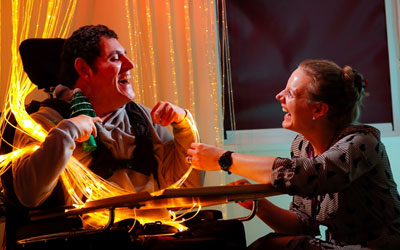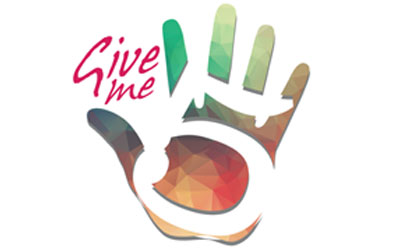 Being able to communicate is essential. It means we can build relationships, express our thoughts and opinions and tell people what we need or want. It also means we can understand what is happening around us and be involved.
Being able to communicate is essential. It means we can build relationships, express our thoughts and opinions and tell people what we need or want. It also means we can understand what is happening around us and be involved.
Sometimes people with a learning disability need support with their communication. This might be help with understanding what other people are saying, or it might mean help with being able to express themselves.
Helping people to understand
How can we help people to understand?
- Think about the words you are using. Keep your speech clear and simple and don’t say too much at once. Also try to say things in the right order.
- Make sure you know how well the person can see and hear you.
 Think about the environment you are in. Is it busy and distracting? Can you improve it?
Think about the environment you are in. Is it busy and distracting? Can you improve it?- Use visual supports to help, like pictures or photographs or objects. You can use templates to write a communication passport or a book about me or a social story. Find templates and information for making a communication passport.
- Simple keyword signing, along with speech, can help illustrate your words. Makaton is a sign and symbol vocabulary that is designed to support people with a learning disability to understand and express themselves. Go to makaton.org if you would like to know more.
Resources that might support you further:
Easyread
A short guide that shows the main things to consider when putting together easy read information.
Social stories
Social stories was created by Carol Gray in 1991 and provides a story framework to describe a difficult or stressful activity, situation or event in a concrete way to provide reassurance and help it make sense.
Helping people communicate with others
- We need to build on the communication skills the person has. We can give people strategies to use if they are having difficulty communicating with others.
 You could try making resources with symbols or pictures or photographs.
You could try making resources with symbols or pictures or photographs.- The person may be using some Makaton signing. Make sure the people who support them have those skills too and can build on them.
- You might need a special resource such as a hospital passport if the person is going into hospital.
Resources that might support you further:
Intensive interaction
- Intensive interaction meets the person as they are, valuing their own way of interacting rather than imposing other ways of communicating on them.
- It helps build relationships by developing social type interactions we have with others such as joking, talking trivia, where nothing much is achieved other than the enjoyment of the other person’s company.
- It gives people confidence in being more social with others as the interaction is led by them and is on their terms without any demands or pressure.
Find out more from intensiveinteraction.org.
This video gives further understanding about how to use this approach.
Talking mats
Talking mats is a way to enable people to express their choices, preferences, feelings or thoughts around a particular topic or decision using a visual scale and options.
Makaton
Makaton uses signs, with speech, in spoken word order; this helps provide extra clues about what someone is saying and a visual reference point. Using signs can help people who have no speech or whose speech is unclear. Using symbols can help people who have limited speech and those who cannot speak, or prefer not to sign.
Search online for “singing hands carpool karaoke” and you will find songs to sing and sign Makaton to.
This is a video of the “this is me” Makaton flash mob organised for learning disability awareness week in 2019.
Visual resources
This is a practical guide about how to make your own visual resources such as planners, keyrings, communication books and includes a section on using a sensory approach for interaction:
Making communication resources (coming soon)
Augmentative and alternative communication (AAC)
Augmentative and alternative communication (AAC) refers to systems and devices that aid communication for people who struggle with speech. These may be simple letter or picture boards or sophisticated computer-based systems. AAC helps someone to communicate as effectively as possible, in as many situations as possible. You can find out more from their website: communicationmatters.org.uk.
iPads can be useful communication tools. Here is a booklet of free apps that can be helpful for communication and interaction: - Free apps for Communication (coming soon) or you can find out more about the most common voice output communication aid (VOCA) apps here: assistiveware.com/products/proloquo2go and here: therapy-box.co.uk.
The KMCAT Service conducts AAC assessments for people with complex needs and supports local therapists in helping everyone else.
This is a useful app for supporting communication around health needs and appointments: myhealthguideapp.com/how-it-helps/
Total communication
 Total communication allows people with communication difficulties and those around them to communicate in the way that is most accessible to them such as through a combination of:
Total communication allows people with communication difficulties and those around them to communicate in the way that is most accessible to them such as through a combination of:
- Speech or vocalisations
- signs or gestures
- symbols photographs or objects
- body language, eye contact and facial expression
- the senses – touch , smell, taste, sight, sound
- the arts – art, music, storytelling
- context – such as clues in the environment or what is going on around.
Resources that can support you further:
Here are two short videos which give good examples of how total communication can be used:
Barry choosing a drink
Bev not wanting to go bowling
An excerpt from the film ‘The Artist’ which shows the power of non verbal communication.
This booklet (coming soon) helps you think about how the person you support communicates and has different ideas about what you can do that might help.
The core and essential service standards for supporting people with profound and multiple learning disabilities show what best practice provision, including communication, looks like for people with profound and multiple learning disabilities. You can find a copy here: Supporting people with PMLD.
“A person’s ability to communicate is not dependent on their being able to master certain skills, it is dependent on our ability to listen and communicate responsively”
Jo Grace, the sensory projects.
Five good communication standards
 Most people with a learning disability have some speech, language and communication difficulties. These can be hidden or overlooked which is why everyone needs to know what good communication looks like. The five good communication standards for best practice make sure reasonable adjustments are made to meet the communication needs of people with a learning disability.
Most people with a learning disability have some speech, language and communication difficulties. These can be hidden or overlooked which is why everyone needs to know what good communication looks like. The five good communication standards for best practice make sure reasonable adjustments are made to meet the communication needs of people with a learning disability.
Using the five good standards of communication helps people who have communication difficulties have good lives.
- Each person will have a communication passport or plan that tells everyone the best ways to communicate with them.
- Each person is supported to be involved in decisions about their life and care.
- We will use the best ways to support each person with their communication.
- We will create opportunities for people to communicate.
- Each person is supported to understand their needs in relation to their health and wellbeing.
Resources that might support you further: